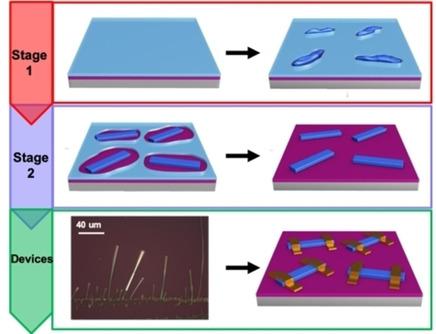当前位置:
X-MOL 学术
›
ChemPhysChem
›
论文详情
Our official English website, www.x-mol.net, welcomes your feedback! (Note: you will need to create a separate account there.)
Crystallization Mechanism of 9,9-Diphenyl-dibenzosilole from Solids.
ChemPhysChem ( IF 2.9 ) Pub Date : 2020-01-07 , DOI: 10.1002/cphc.201900925 Mingliang Li 1, 2 , Xiaoge Wang 3, 4 , Guozhi Wang 1, 2 , Shizhao Ren 3, 4 , Shuo Li 1, 2 , Feng Wei 1, 2 , Shouke Yan 5 , Xuefeng Guo 3, 4 , Hailing Tu 1, 2
ChemPhysChem ( IF 2.9 ) Pub Date : 2020-01-07 , DOI: 10.1002/cphc.201900925 Mingliang Li 1, 2 , Xiaoge Wang 3, 4 , Guozhi Wang 1, 2 , Shizhao Ren 3, 4 , Shuo Li 1, 2 , Feng Wei 1, 2 , Shouke Yan 5 , Xuefeng Guo 3, 4 , Hailing Tu 1, 2
Affiliation

|
Organic semiconductor (OSC) crystals have great potential to be applied in many fields, as they can be flexibly designed according to the demands and show an outstanding device performance. However, OSCs with the capacity of solid‐state crystallization (SSC) are developing too slowly to meet demands in productions and applications, due to their difficulties in molecular design and synthesis, unclear mechanism and high dependence on experimental conditions. In this work, in order to solve the problems, we synthesized an organic semiconductor capable of SSC at room temperature by adjusting the relationship between conjugated groups and functional groups. The thermodynamic and kinetic properties have been studied to discover the model of film SSC. Moreover, it can be purposefully controlled to prepare the high‐quality crystals, and their corresponding organic electronic devices were further fabricated and discussed.
中文翻译:

固体中9,9-二苯基-二苯并甲硅烷基的结晶机理。
有机半导体(OSC)晶体具有很强的潜力,可以在许多领域中应用,因为它们可以根据需求灵活地设计并显示出出色的器件性能。但是,由于具有固态结晶(SSC)能力的OSC的分子设计和合成困难,机理不明确以及对实验条件的高度依赖,因此发展太慢,无法满足生产和应用需求。在这项工作中,为了解决这些问题,我们通过调节共轭基团与官能团之间的关系,合成了一种能够在室温下实现SSC的有机半导体。已经研究了热力学和动力学性质以发现膜SSC的模型。而且,可以有目的地控制它以制备高质量的晶体,
更新日期:2020-01-07
中文翻译:

固体中9,9-二苯基-二苯并甲硅烷基的结晶机理。
有机半导体(OSC)晶体具有很强的潜力,可以在许多领域中应用,因为它们可以根据需求灵活地设计并显示出出色的器件性能。但是,由于具有固态结晶(SSC)能力的OSC的分子设计和合成困难,机理不明确以及对实验条件的高度依赖,因此发展太慢,无法满足生产和应用需求。在这项工作中,为了解决这些问题,我们通过调节共轭基团与官能团之间的关系,合成了一种能够在室温下实现SSC的有机半导体。已经研究了热力学和动力学性质以发现膜SSC的模型。而且,可以有目的地控制它以制备高质量的晶体,


























 京公网安备 11010802027423号
京公网安备 11010802027423号